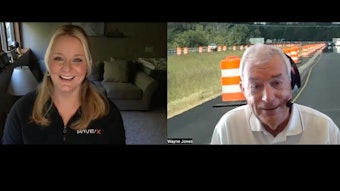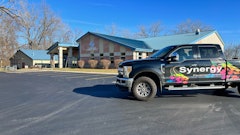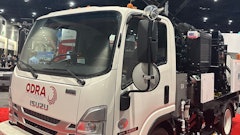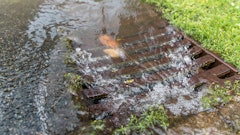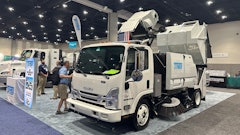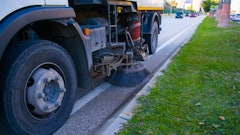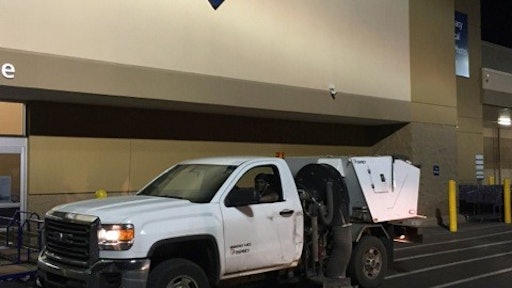
In the sweeping industry, time is money. The more time you spend on one job, the less time you have for the next sweep. The less sweeps you complete, the less money you make.
This is why it’s especially important for sweeping contractors to make the most out of every single second when they’re out sweeping. Contractors offer insight on what tactics work best for them to complete the most efficient sweep possible.
Your Crew is Key
Your crew is the beginning and end of everything. Finding and cultivating good operators is imperative to the success of your business.
“Start training the day you hire them,” Jim Blackerby, owner of Lexington Pavement Sweep says. “I let new hires ride with me so they can see where the jobs are located and I talk to them about each place.”
Next, Blackerby has another team member take the new hire under their wing to shadow them in the passenger seat of the sweeper for a few nights.
Once the new hire sees what needs to be done, he’ll get out of the truck a few nights later and assist in the sweep by blowing out the sidewalks and completing other tasks for the driver. Then the roles will reverse so the new hire gets the driver training before he’s sent out on his own.
The reason for driver training is because those operators who have less experience are more likely to make costly mistakes. As with other types of equipment that typically requires only one on-board operator, (airplanes for example) beginners benefit greatly from a skilled professional before they are allowed to solo. This also applies to mechanics responsible for maintenance and adjustments to the machine.
“When an operator is learning, they’re going to realize right away if what they are doing is right or wrong,” Blackerby says. “Maybe they realize they’re blowing in to the wind and they can’t get everything off the sidewalk. They’ll only make that mistake one time. Next time, they’ll check the wind first. Each night they’re getting more efficient.”
When it comes to sweeper operation, Blackerby is clear on what he expects in terms of driver behavior.
“You don’t sweep a parking lot like you’re mowing grass,” Blackerby says. “Not every inch of the pavement needs the sweeper to drive over it, but you do need to cover all areas to make sure there’s nothing there.
“One thing I always tell the guys in regards to operation, is that driving faster does not speed things up. Driving slow can lead to a driver being more efficient. If you’re going too fast past one area, you may not be able to get to the debris. This means you have to circle around to pick it back up. I tell them to drive around 5mph and swerve back and forth to get everything in one pass without having to come back to get something you missed.”
Blackerby also tells his crew to turn their trucks off and reduce idling time to increase efficiency.
Giving your crew something to work for can also lead to a more efficient operator. For each sweeping machine you, there should be a primary person assigned to operate it. The benefit of this arrangement is that operators feel both pride in, and responsibility for, the expensive piece of equipment they are assigned to use and the jobs they complete with their machine. Also, by working in one machine exclusively, the operator becomes familiar with its personality and quirks, and can develop a skill that gets the most from the machine.
Make a Plan
Having your routes planned out is a no-brainer in this industry. Finding the fastest routes to each location and grouping jobs based on proximity to each other is something contractors have been doing for years. Some companies have even developed routing software that helps contractors to better optimize the sweeping routes.
“Most all of your routes will already be set,” Blackerby says. “The contract work is set and done week after week. Once the schedules are made, they pretty much stay the same. Using a GPS, you can see on the map how efficient the routes are for your crew. You want to minimize excessive drive time and never want your operator to have to double back on a route.”
Blackerby says that by studying the GPS, he’s been able to create more efficient routes. “You may have a route that you think is full, but by studying the GPS you can tell if there is wasted drive time. If you correct that, you may be able to save an hour or two, which means that driver can now pick up another shopping center on his route. That is 100% profit to the bottom line.
Blackerby says that excessive drive-time is downtime, which may cause you to charge a much higher rate to cover your expenses, but if you’re efficient and you keep the trucks working you can be more flexible with the price you charge.
“The whole business is based on time. You buy the sweeper and then you’re basically just selling time in the truck. The more efficient the route, the more places you can sweep. And the more places you can sweep in a night, the more competitive you can be with your price.”
Maintain to Stay in the Green
Your sweepers aren’t going to make any money if they’re broken down and not on a jobsite. This is why maintenance should be an important part of your fleet operation.
“You can do all the planning you want with routes and scheduling, but if a truck goes down in the middle of the night, everything is out the window,” Blackerby says. “If a truck goes down, there is no efficiency. Maintain the trucks during the day for successful sweeps at night.”
One thing most contractors agree on that helps in sweeper maintenance is the installation of an automatic greasing system on the sweeper. This lowers daily maintenance time, and ensures immediate and frequent lubrication for machines that work in dusty conditions. It also reduces premature wear on critical parts, which can reduce unscheduled maintenance and may reduce the need to have more back-up machines available.
An automatic greasing system uses a large reservoir of grease and numerous lines that feed the grease to critical moving parts of the machine--those places that would normally be greased by the operator or mechanic on a daily basis. These parts are greased on a regular time interval (2 to 3 minutes) while the machine is operating. The system costs an estimated $1,800 installed, and based on a 10-year life expectancy at 350 hours per year, adds $0.50 per operating hour.
Two for the Money
One thing that may be surprising on sweeping routes, is that two guys in a truck can actually lead to a more efficient sweep than just having the one driver.
After spending thousands on a college education, Blackerby’s son Jimmy opened his own business, Louisville Pavement Sweep, and operates under this premise.
“Using two people in a truck really speeds up the process of cleaning a place,” Jimmy says. “You have one person on the ground blowing the sidewalks, emptying the garbage cans and cleaning up the gutters while the driver is sweeping. This way the driver doesn’t have to park the sweeper and do that work himself while the truck sits. You can get more places done in a night by having two people work this way.”
Jimmy says this allows him to offer a more competitive price to his customers as well. "I'm able to offer a lower price knowing that it's going to take me less time to get the parking lot clean. The more efficient you are, the more places you're able to sweep in a night and doing it faster means you can bid the job at a lower price to your customer."
Both father and son agree that it is considerably less costly to use a two man crew. "You already own the truck, it costs less to clean additional parking lots than it does to buy a new sweeper to clean those additional lots."





